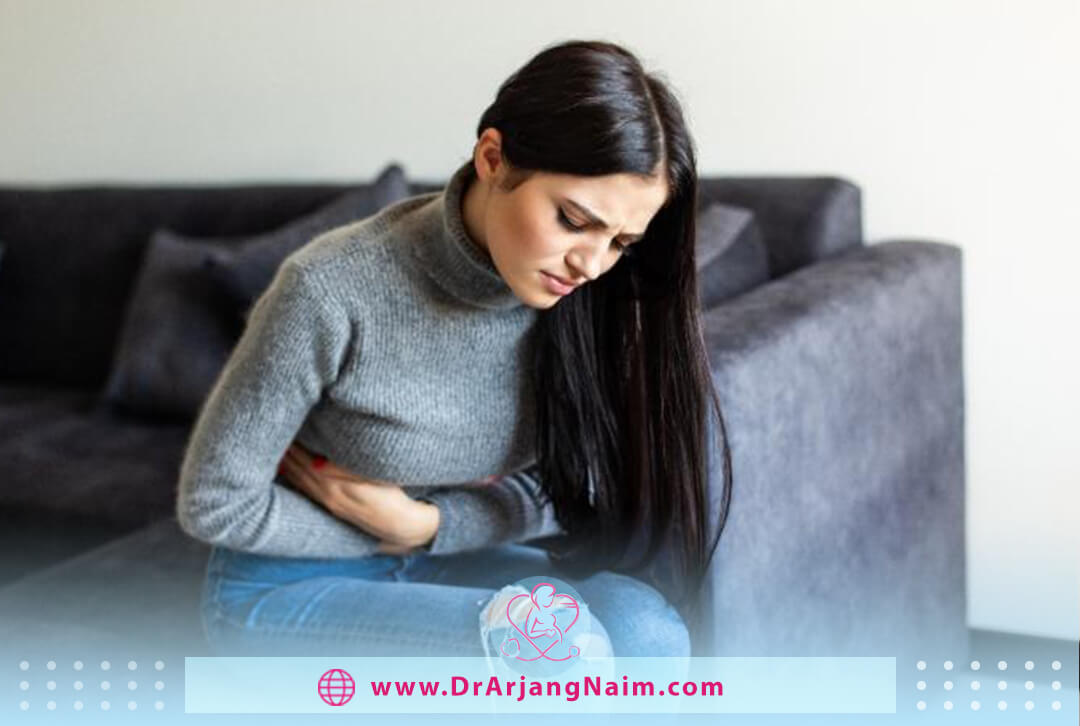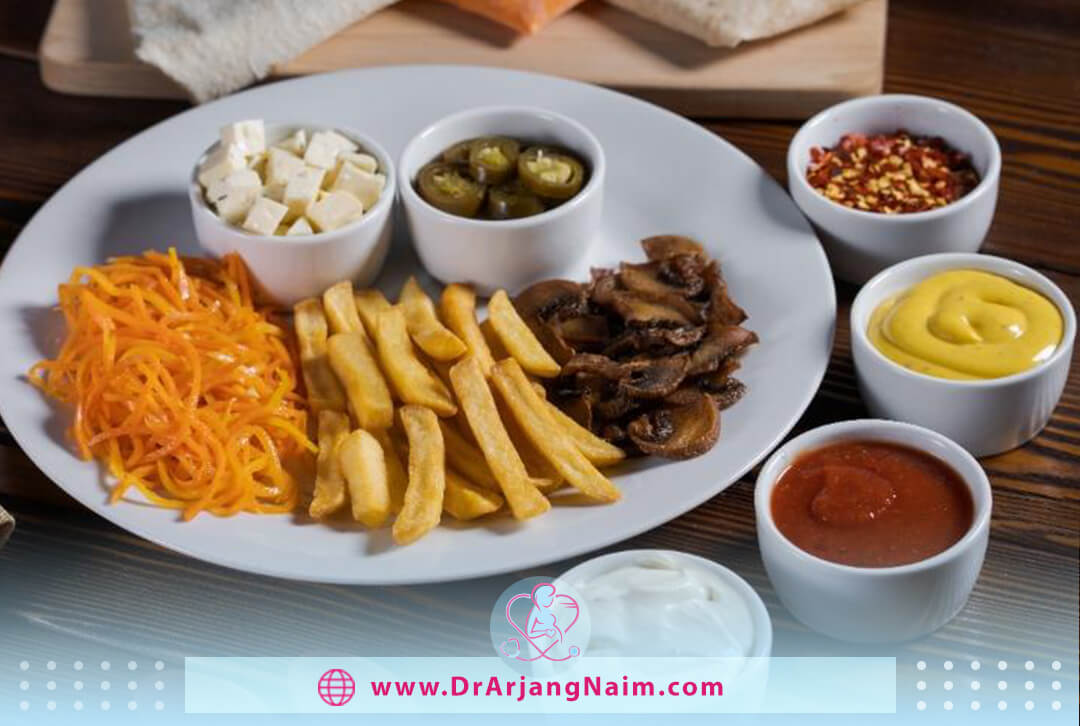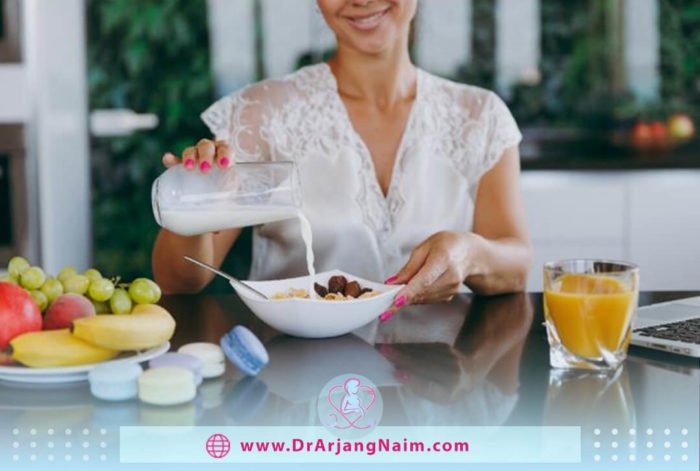Endometriosis is an often-painful disorder in which tissue similar to the tissue that normally grows inside the uterus develops outside the uterus. It usually involves the ovaries, fallopian tubes, and pelvic lining. Rarely, endometrial tissue may spread to the pelvic organs. Endometrial tissue thickens, breaks down, and bleeds with each menstrual cycle. In this inflammatory disease, this tissue has no way out of the body; it gets trapped. When endometriosis affects the ovaries, cysts called endometrium may form. The surrounding tissues can become irritated, eventually creating scar tissue and adhesions.
The main symptom of this disorder is pelvic pain, often during menstruation. Although many women experience abdominal pain during menstruation, women with endometriosis generally experience much worse menstrual pain than usual. Avoiding foods and beverages that cause inflammation and increase estrogen production can help treat the painful symptoms of the disease.
Symptoms

The main symptom of this disorder is pelvic pain, which is often associated with menstrual periods. Although many people experience muscle cramps during menstruation, people with endometriosis typically describe menstrual cramps as much worse than usual. The pain may also increase over time. Common signs and symptoms include:
- Painful periods (dysmenorrhea)
- Pain with intercourse
- Pain with bowel movements or urination
- Excessive bleeding
- Infertility
- Pain in the lower abdomen before and during menstruation
- Fatigue
- Diarrhea
- Bloating
- Constipation
Causes
The exact cause of this disorder is not known, but possible explanations include:
- Retrograde menstruation: In retrograde menstruation, menstrual blood containing endometrial cells returns through the fallopian tubes and into the pelvic cavity instead of out of the body. These endometrial cells attach to the walls of the pelvis and the surfaces of the pelvic organs, grow there, and thicken and bleed during each menstrual cycle.
- Transformation of peritoneal cells: Hormones or immune factors turn peritoneal cells into endometrial-like cells.
- Embryonic cell transformation: Hormones like estrogen may turn embryonic cells into endometrial-like cells implanted during puberty.
- Surgical scar implantation: Endometrial cells may attach to a surgical incision after surgery, such as a hysterectomy or C-section.
- Endometrial cell transport: Blood vessels or the tissue (lymphatic) system may carry endometrial cells to other parts of the body.
- Immune system disorder: Problems with the immune system may not enable the body to identify and destroy endometrial-like tissue that grows outside the uterus.
The link between endometriosis and diet
Eating certain foods stimulates or relieves the symptoms of this inflammatory disease. A 2013 study found that women who ate more vegetables and omega-3 fatty acids were protected against the symptoms of endometriosis, while those who ate red meat, trans fats, and coffee had the opposite effect.
A 2015 literature review shows that eating a healthy diet can prevent the progression of endometriosis. Foods in this diet include:
- Fruits
- the vegetables
- Whole grains
- Omega 3 fatty acids
A person cannot prevent the disease from occurring, but they can reduce their risk by avoiding foods and chemicals that increase their estrogen levels. These include caffeine and alcohol. To be aware of the effect of food on their symptoms, the sufferer can prepare a food journal. It is essential that they record everything they eat during the day, as well as the symptoms they experience. It may be necessary to keep a diary for a while, as a clear pattern may not appear immediately.
Foods that may negatively affect

Some lifestyles can affect the progression of this disorder and increase the risk of developing it. These choices can also affect whether the disorder is painful or manageable. However, more research must be done to link certain foods or lifestyle habits fully to developing or worsening these conditions.
Trans fat
Trans fats can be found naturally in animal products or added to processed foods for flavor and texture. But trans fats can raise bad cholesterol (LDL) levels and lower good cholesterol (HDL) levels. Eating trans fats also increases the risk of heart disease, stroke, and type 2 diabetes.
Trans fats tend to show up in fried, processed, and fast foods and can be shown on food labels as “partially hydrogenated oils.” Higher rates of endometriosis are found in women who consume more trans-fat.
Red meat
A review of studies on diet and endometriosis found that there was a link between eating beef, ham, and other red meats and a higher risk of endometriosis. The exact reason for this connection is not clear, but research has shown that red meat may cause inflammation in the body, and inflammation may exacerbate this disorder.
Gluten
Gluten is a protein found in most cereals and usually acts as a binder in bread and baked goods. Over the past few years, a gluten-free diet has become a common lifestyle diet. Gluten can reduce the symptoms of endometriosis.
FODMAP diet
FODMAP is actually fermented from oligo, di, monosaccharides, and polyols. These are actually scientific terms for grouping carbohydrates that irritate the digestive system and cause problems such as bloating, gas, and stomach pain. Food dumps are found in a large number of foods and in varying amounts. The main sources of the four groups of FODMAPs include:
- Oligosaccharides: Wheat, rye, legumes, and various fruits and vegetables, such as garlic and onions.
- Disaccharides: Milk, yogurt, and soft cheese. Lactose is the main carb.
- Monosaccharides: Various fruit, including figs and mangoes, and sweeteners such as honey and agave nectar. Fructose is the main carb.
- Polyols: Certain fruits and vegetables, including blackberries and lychee, as well as some low-calorie sweeteners like those in sugar-free gum.
Symptoms are significantly improved in patients with irritable bowel syndrome (IBS) and endometriosis following a low-FODMAP diet.
Caffeine and Alcohol
Health professionals often advise women with endometriosis to reduce their caffeine and alcohol intake. Alcohol and caffeine consumption are both associated with increased levels of estrogen, a protein that carries estrogen throughout the body. Although there is no clear evidence that caffeine or alcohol is associated with the risk or severity of endometriosis, some women still prefer to reduce or eliminate these substances from their diet.
Processed Foods
Minimizing the consumption of processed foods is a good idea for everyone and also helps manage this inflammatory disease. Processed foods are often high in unhealthy fats and sugars, low in nutrients and fiber, and can cause pain and inflammation.
As a result, limiting the intake of foods such as sweets, chips, crackers, candy, and fried foods may help reduce the pain associated with endometriosis. For greater effectiveness, replace processed foods with foods that help manage endometriosis, such as fatty fish, whole grains, or fresh fruits and vegetables.
Foods that may positively affect

To combat the inflammation and pain caused by endometriosis, it is best to eat a well-balanced, nutrient-rich diet that is essentially plant-based and full of vitamins and minerals.
Vegetables with B vitamins
A healthy liver with large amounts of B vitamins can break down estradiol into estriol. Estriol is a form in which estrogen can attach to and be excreted in fiber. The diet should have enough fiber and B vitamins from green vegetables to help the body cope with the constant breakdown of circulating estrogens. Leafy greens can also help the nervous system and immune systems, and magnesium relaxes the smooth muscles of the intestines and uterus.
Iron-rich foods
Iron is a key component of hemoglobin, a protein in red blood cells that carries oxygen from the lungs to tissues, and low iron levels can cause symptoms such as fatigue and difficulty concentrating. With endometriosis, heavy bleeding may occur, so the replacement of lost iron is important. There are two types of iron in foods, heme iron from protein sources and non-heme iron from other plant sources. Non-heme iron is also found in green, leafy vegetables, beets, dried apricots, and plain chocolate. Heme Iron is also obtained from red meat, eggs, and fish.
Omega fatty acids
Omega-3 fatty acids are important components of the membrane that surrounds every cell in the body. They also give energy to the body and make important organs such as the heart and lungs work well. People who use omega-3 fatty acids have less pain and inflammation in endometriosis, and even improve the quality of life in people with severe endometriosis. Avoid trans fats, and keep saturated fats low. Sources of omega fatty acids include oily fish such as wild Alaskan salmon and Pacific halibut, tree nuts, seeds, and extra virgin cold-pressed olive oil.
Antioxidant-rich foods
Antioxidants are man-made or natural substances that may prevent or delay some cell damage. They reduce inflammation and thus reduce symptoms. Foods rich in antioxidants are found in colorful fruits and vegetables. Antioxidants can also be used as supplements.
Fiber
Eat 30 grams of fiber every day from fruits, vegetables, nuts, seeds, legumes, and whole grains, including rye, oats, rice, corn, millet, and buckwheat, to keep your gut healthy and eliminate excess estrogen.
Water
Drink four to six glasses of 8 ounces of water daily. Avoid caffeine, refined sugars, sweeteners, soft drinks, and alcohol when fighting this disorder or trying to get pregnant.
Supplements that may help
In addition to having a healthy diet, supplements can also be helpful. Taking Zinc and Vitamins A, C, and E Supplements. Women with this disorder who took these supplements reduced peripheral oxidative stress markers and increased antioxidant markers. Curcumin may also help manage endometriosis. This anti-inflammatory substance is present in turmeric. Curcumin inhibits endometrial cells by reducing estradiol production.
Research also shows that women with higher levels of vitamin D and those who consume more dairy in their diet have reduced levels of endometriosis. In addition to vitamin D, calcium and magnesium from foods or supplements may also be helpful.
Exercise and other treatments
Exercise is one of the most effective measures to control the symptoms of endometriosis because it reduces the level of estrogen and increases the hormones that make a person feel better. Other measures and treatments that are effective in controlling this disorder include:
- Meditation
- Yoga
- Acupuncture
- Massage
The bottom line
One of the most common causes of painful menstruation in women is endometriosis. It is an inflammatory disease that occurs when endometrial cells spread beyond the uterine cavity. There is no cure for endometriosis, and surgical or medical treatments are still the most effective ways to manage the disease.
However, dietary changes are complementary approaches that may help some women manage their symptoms. Keep in mind that as the symptoms of the disease vary from person to person, treatments that work best for one woman may not work for another.
Additional questions
- Can endometriosis physical therapy be useful?
Physiotherapy can be used to treat endometriosis. Pelvic floor physiotherapy can help improve the function, flexibility, and strength of the pelvic floor muscles, and ultimately can help reduce the symptoms of endometriosis.
- Does stress trigger endometriosis?
Clinical studies clearly show that endometriosis is a condition associated with high levels of chronic stress. The intensity of stress is related to the intensity of pain and the spread of the disease.
- How serious is endometriosis?
While endometriosis is a painful disease that can affect the quality of life, it is not considered fatal. In very rare cases, endometriosis complications can cause potentially life-threatening problems.
- What will happen if endometriosis is left untreated?
Over time, endometrial-like tissue that grows outside the uterus can cause cysts, adhesions, and scar tissue. This can cause you to experience long-term (chronic) pain (especially during menstrual periods).
- How do doctors check for endometriosis?
The only way to be sure if endometriosis is present or not is to use a minor surgical procedure called laparoscopy.
References
https://www.healthline.com/nutrition/endometriosis-diet-tips
https://www.medicalnewstoday.com/articles/321471
https://www.everydayhealth.com/womens-health/essentials-of-endometriosis-diet.aspx
https://www.health.com/condition/endometriosis/endometriosis-diet
https://www.mayoclinic.org/diseases-conditions/endometriosis/symptoms-causes/syc-20354656
https://www.healthline.com/health/endometriosis




